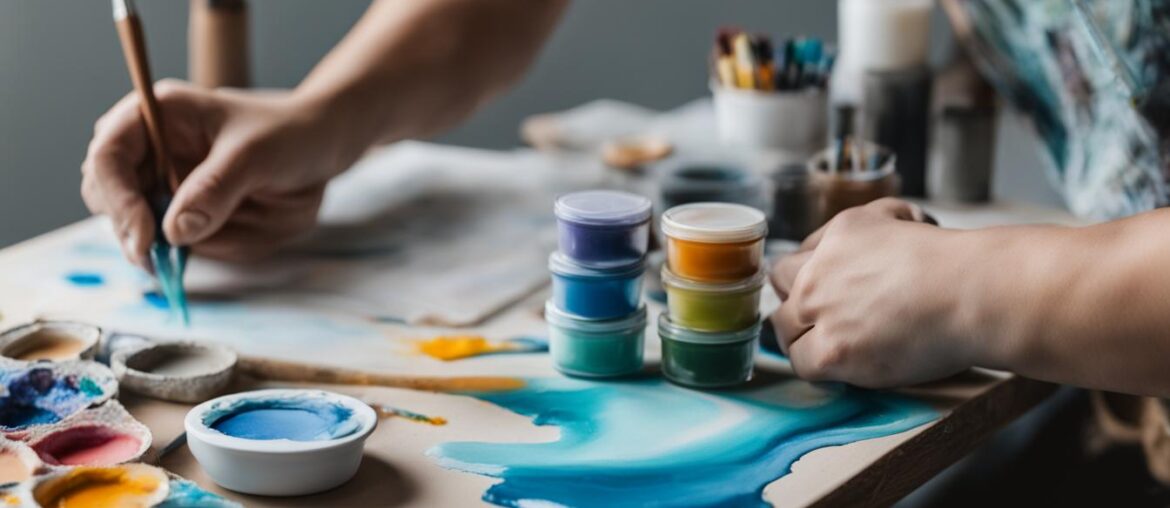Living with anxiety can feel overwhelming and debilitating. It's a constant battle with your own thoughts and emotions, an invisible weight that seems impossible to shake off. I know this struggle all too well.
For years, anxiety consumed me, preventing me from fully enjoying life and seizing opportunities. It wasn't until I discovered the power of art therapy that I began to find relief and regain control over my anxious mind.
Our Top Pick For Beating Panic Attacks
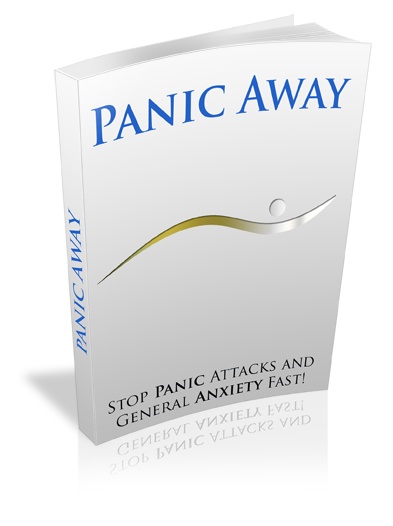
Stopping, and preventing, panic attacks is now even easier.
Art therapy exercises have become a sanctuary for me, a safe space where I can express my fears, hopes, and dreams through creative means. They have given me a way to confront my anxiety head-on and find solace in the process.
Through my personal journey, I have discovered several art therapy exercises that have provided immediate anxiety reduction and brought me a sense of peace like no other. In this article, I want to share these exercises with you, so that you too can experience the transformative power of art therapy.
Key Takeaways:
- Art therapy exercises can be a powerful tool for reducing anxiety and promoting immediate relaxation.
- Engaging in art therapy allows individuals to express their emotions and find peace through creativity.
- These exercises provide a safe space to confront anxiety and regain control over anxious thoughts.
- Art therapy exercises offer a transformative journey towards reducing anxiety and finding inner peace.
- By incorporating art therapy techniques into daily life, individuals can effectively manage anxiety and improve overall mental well-being.
What is Anxiety?
Anxiety is a common mental health issue characterized by excessive fear and worry. It can manifest as stress, nervousness, or restlessness. Anxiety can affect our daily lives and disrupt our ability to function normally. Understanding what anxiety is and its different subtypes is crucial in addressing and managing it effectively.
The Different Subtypes of Anxiety:
- Generalized anxiety disorder (GAD): Persistent, excessive worry and fear about everyday situations.
- Panic disorder: Recurring panic attacks characterized by sudden and intense fear.
- Social anxiety disorder (SAD): Fear and avoidance of social situations due to worry of being judged or embarrassed.
- Specific phobias: Overwhelming fear and avoidance of specific objects or situations.
- Obsessive-compulsive disorder (OCD): Intrusive thoughts and compulsive behaviors to alleviate anxiety.
- Post-traumatic stress disorder (PTSD): Anxiety triggered by past traumatic experiences.
Anxiety can range from mild to severe, and its symptoms may vary among individuals. Common symptoms include:
- Racing heart
- Difficulty concentrating
- Restlessness
- Trouble sleeping
- Irritability
It's important to remember that anxiety is a treatable condition. Various therapeutic approaches, including art therapy exercises, are effective in managing anxiety and promoting overall well-being. Let's explore the benefits of art therapy for anxiety in the next section.
https://www.youtube.com/watch?v=yhKL3CuUxNs
Benefits of Art Therapy for Anxiety
Art therapy offers a wide range of benefits for individuals struggling with anxiety. Through creative expression, art therapy can have a profound impact on mental well-being and provide relief from anxious thoughts and emotions.
Regulates the Nervous System:
Engaging in art therapy has been shown to regulate the nervous system, promoting a sense of calm and reducing anxiety levels. It helps activate the parasympathetic nervous system, which is responsible for rest and relaxation, leading to a decrease in stress and anxiety.
Reduces Rumination:
Art therapy acts as a powerful tool to break the cycle of rumination, which is a common symptom of anxiety. By engaging in creative activities, individuals can shift their focus away from repetitive, negative thoughts and redirect their attention towards the present moment.
Encourages Focus and Mindfulness:
Art therapy exercises require individuals to be fully present in the creative process. This promotes mindfulness, allowing individuals to concentrate on the task at hand and let go of anxious thoughts. It helps cultivate a sense of focus and promotes a state of flow, where individuals become deeply engaged in the creative activity.
Increases Self-Esteem:
Engaging in art therapy can boost self-esteem and confidence. By creating artwork, individuals witness their own creative abilities and experience a sense of accomplishment. This fosters a positive self-image and enhances overall self-worth.
Provides a Distraction from External Stressors:
Art therapy serves as a valuable distraction from external sources of stress and anxiety. By immersing themselves in the creative process, individuals can temporarily shift their focus away from worries and find solace in the act of creation.
Promotes Self-Expression:
Through art therapy, individuals have a unique platform to express their emotions, thoughts, and experiences. Art becomes a non-verbal form of communication, allowing for the exploration and release of pent-up feelings that may be contributing to anxiety.
By engaging in art therapy, individuals can experience a sense of calm, improved well-being, and enhanced problem-solving skills. It is a powerful tool for managing anxiety and fostering a positive mindset.
| Benefits of Art Therapy for Anxiety | Summary |
|---|---|
| Regulates the Nervous System | Promotes relaxation and reduces stress |
| Reduces Rumination | Helps break the cycle of negative thoughts |
| Encourages Focus and Mindfulness | Promotes concentration and being present in the moment |
| Increases Self-Esteem | Boosts self-confidence and a positive self-image |
| Provides a Distraction from External Stressors | Offers temporary respite from worries and anxieties |
| Promotes Self-Expression | Allows for the exploration and release of emotions |
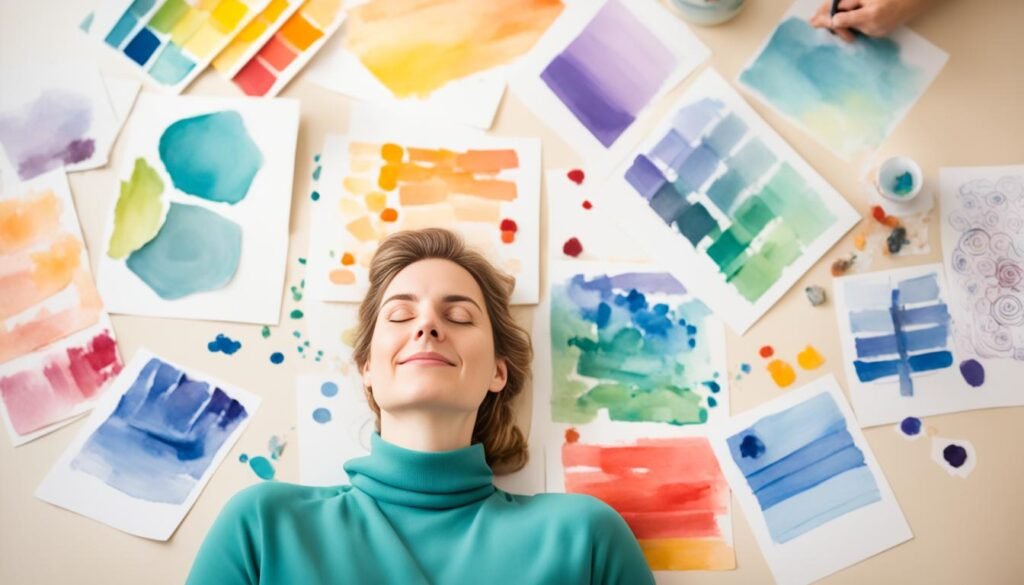
Art therapy is a powerful and effective approach to managing anxiety. By harnessing the therapeutic benefits of art, individuals can find relief and embark on a journey of self-discovery and healing.
Mind-Body Connection Exercise
To further explore the intricate relationship between our mind and body, the Mind-Body Connection exercise offers a unique opportunity for self-reflection and relaxation. By engaging in this exercise, individuals can deepen their awareness of physical sensations and tensions within the body, fostering a stronger connection between the mind and body.
Here's how the Mind-Body Connection exercise works:
- Find a quiet and comfortable space where you can focus on your body and engage in drawing.
- Take a few deep breaths to relax and center yourself.
- Using a large piece of paper or canvas, draw the outline of a body, either your own or a generic representation.
- As you begin to draw, pay close attention to any physical sensations or tensions you may be experiencing in different areas of your body.
- For example: If you notice tightness in your shoulders, include that in your drawing by adding additional lines or shading to depict the tension.
- Or: If you experience a fluttering sensation in your stomach, incorporate that feeling into your drawing through the use of shapes or colors.
- Continue to add to your drawing, using the physical feelings as a guide, allowing your body's sensations to inform the artwork.
- Take your time and let the drawing process be a form of mindfulness, focusing on the present moment and your body's signals.
Through the Mind-Body Connection exercise, individuals can gain a deeper understanding of the physical manifestations of anxiety or stress within their bodies. This heightened awareness creates an opportunity for relaxation, as well as the ability to more effectively address and manage these sensations.
Engaging with the Mind-Body Connection exercise enables me to tap into the wisdom of my body and gain insight into the ways my thoughts and emotions impact my physical state. By incorporating my physical sensations into my artwork, I feel a sense of empowerment and control over my anxiety. It's a powerful exercise that helps me find balance and peace within myself.
By bringing attention to the mind-body connection and integrating it into the creative process, this exercise offers a powerful tool for reducing anxiety and promoting overall well-being. The Mind-Body Connection exercise serves as a reminder that our bodies hold valuable insights and can play an active role in our mental health journey.
Next, let's explore the 1 Minute Brain Dump exercise.
1 Minute Brain Dump Exercise
The 1 Minute Brain Dump exercise is a simple yet effective method for releasing anxious thoughts and worries. It allows you to quickly write or draw all your overwhelming thoughts in a designated space, helping you let go of anxiety and gain a sense of relief. By externalizing your concerns onto paper, you can free up mental space and reduce the burden of anxiety.
To perform the 1 Minute Brain Dump exercise, follow these steps:
- Find a quiet and comfortable place where you can focus.
- Take a piece of paper and draw a large thought bubble in the center.
- Set a timer for one minute.
- During that minute, let your thoughts flow freely and quickly write or draw all your anxious thoughts or worries inside the thought bubble.
- Do not judge or analyze your thoughts during this time. The goal is to release them without restraint.
- Once the timer goes off, take a deep breath and acknowledge that you have given space to your anxious thoughts.
- Review your brain dump and reflect on the thoughts and worries you have expressed.
This exercise can help you gain clarity on your concerns, identify recurring patterns, and recognize any common themes. By externalizing your thoughts, you create a tangible representation of your anxiety, which can help you distance yourself from it and gain a fresh perspective.
Remember, the goal of the 1 Minute Brain Dump exercise is not to solve every worry or concern instantly but to acknowledge them and create space for further reflection. This exercise can be used whenever you feel overwhelmed by anxious thoughts and need a quick release.
“The 1 Minute Brain Dump exercise is a powerful tool for quickly releasing anxious thoughts and worries. It allows me to externalize my concerns and gain a sense of relief.” – Emily
Give the 1 Minute Brain Dump exercise a try and see how it can help you let go of overwhelming thoughts and reduce anxiety.
Additional Tips:
- Consider using colorful markers, pencils, or pens for your brain dump to add an expressive element to your thoughts.
- If you find it challenging to let your thoughts flow freely, try closing your eyes and focusing on your breath before starting the brain dump.
- Once you have completed the exercise, you can choose to keep your brain dump as a visual reminder of the thoughts you've released or safely discard it if you prefer.

Mind Map Anxiety Exercise
In this exercise, you can create a mind map to gain a deeper understanding of your anxiety. A mind map is a visual tool that helps you explore and organize your thoughts and ideas. By mapping out the different components of your anxiety-inducing situation, you can identify triggers, emotional and physical feelings, negative thoughts, and calming techniques.
To create a mind map, start by drawing a circle in the center of a blank piece of paper. In the circle, write the main anxiety-inducing situation or event. From the center circle, draw branches outward, connecting them to smaller circles or shapes. Each smaller circle represents a different component of your anxiety.
Use keywords, short phrases, or simple drawings to represent these components. For example, one branch could focus on triggers, where you write or draw the things that set off your anxiety. Another branch could address emotional and physical feelings, where you describe or illustrate the sensations you experience.
Example:
- Triggers: Public speaking, crowded spaces
- Emotional and Physical Feelings: Rapid heartbeat, shortness of breath
- Negative Thoughts: “I'll embarrass myself,” “I can't handle it”
- Calming Techniques: Deep breathing, positive affirmations
As you explore each component, you may discover patterns or connections between them. This can help you gain insight into the underlying causes of your anxiety and identify effective coping strategies. Mind mapping allows you to see the bigger picture of your anxiety and find ways to address it.
Remember, there are no right or wrong answers when creating a mind map. This exercise is about personal reflection and self-discovery. Feel free to add as many branches and components as you need to capture the complexity of your anxiety. Be open to revisiting and updating your mind map as your understanding of your anxiety evolves.
| Component | Example |
|---|---|
| Triggers | Public speaking, crowded spaces |
| Emotional and Physical Feelings | Rapid heartbeat, shortness of breath |
| Negative Thoughts | “I'll embarrass myself,” “I can't handle it” |
| Calming Techniques | Deep breathing, positive affirmations |
Gratitude Journaling Exercise
One powerful exercise for reducing anxiety and promoting a sense of well-being is the Gratitude Journaling exercise. Journaling allows individuals to explore and cultivate gratitude in different areas of their lives. Whether done in a general sense or focused on specific situations that cause anxiety, the act of practicing gratitude can have a transformative effect on our mental state.
By shifting our perspective and intentionally focusing on the positive aspects of our lives, we can counterbalance the negative thoughts and worries that contribute to anxiety. Gratitude journaling helps us recognize the good that surrounds us, even in challenging times, and empowers us to find moments of joy, peace, and appreciation.
When engaging in the Gratitude Journaling exercise, take a few moments each day to reflect on what you are grateful for and record it in your journal. It could be something as simple as a beautiful sunset, a supportive friend, or a small personal achievement.
“Gratitude turns what we have into enough.” – Melody Beattie
Expressing gratitude through journaling not only helps reduce anxiety but also promotes a positive mindset and emotional well-being. It encourages us to focus on the present moment and find meaning and value in our lives. It can be a gentle reminder that there is always something to be grateful for, no matter how small or seemingly insignificant.
Consider using the following journaling prompts to guide your gratitude practice:
- What are three things I am grateful for today?
- Who or what made me smile or feel loved today?
- What progress or growth have I experienced recently?
- What challenges have I overcome, and what have I learned from them?
- How have acts of kindness impacted my day?
- What qualities do I appreciate about myself?
Remember: There is no right or wrong way to practice gratitude journaling. It is a personal exercise that should reflect your unique experiences and feelings. Use your journal as a safe space to explore and celebrate gratitude, allowing it to support you in reducing anxiety and cultivating a positive mindset.

| Benefits of Gratitude Journaling Exercise |
|---|
| 1. Reduces anxiety by shifting focus towards positive aspects of life. |
| 2. Promotes emotional well-being and a positive mindset. |
| 3. Provides an opportunity for self-reflection and personal growth. |
| 4. Fosters a sense of appreciation for the present moment. |
| 5. Encourages gratitude for even the smallest joys and blessings. |
Visual Starter Exercise
The visual starter exercise is a fantastic art therapy technique for individuals who may feel anxious about creating art. This exercise provides a starting point and prompts for inspiration, making the process more accessible and enjoyable.
Here's how it works:
- Begin by selecting a visual stimulus, such as a photograph, painting, or image that resonates with you. This stimulus will serve as the foundation for your artwork.
- Take a moment to observe the visual stimulus and let your thoughts and emotions flow freely. Notice the colors, shapes, textures, and overall mood of the image.
- Now, using the visual stimulus as a reference, start creating your own artwork. You can use any medium that you feel comfortable with, whether it's paint, pencils, collage, or digital art.
- As you work on your artwork, let yourself be inspired by the visual stimulus. Don't worry about replicating it exactly—instead, focus on incorporating elements that speak to you and evoke emotions.
- Allow your creativity to guide you. Experiment with different techniques, colors, and compositions. Don't be afraid to take risks and explore new ideas.
The visual starter exercise not only helps overcome the fear of a blank canvas but also encourages self-expression and personal interpretation. It allows you to tap into your creative instincts and explore your unique artistic style.
“Art enables us to find ourselves and lose ourselves at the same time.” – Thomas Merton
Creating art based on a visual starter can be a deeply immersive and rewarding experience. It allows you to step into a world of creativity, where your anxieties fade into the background, and the focus is on self-discovery and expression.
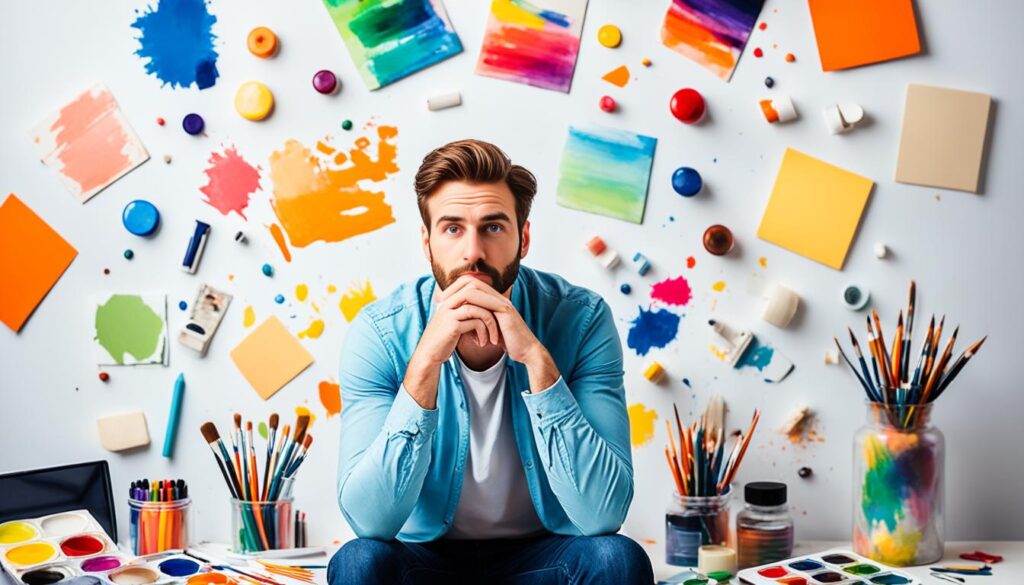
| Benefits of the Visual Starter Exercise |
|---|
| Helps overcome the fear of a blank canvas |
| Serves as a source of inspiration |
| Enhances self-expression |
| Encourages exploration of personal artistic style |
| Provides a creative outlet for emotions |
Worry Cloud Exercise
The Worry Cloud exercise is a powerful art therapy technique that can help individuals externalize their worries and find relief from anxious thoughts. To perform this exercise, follow these steps:
- Create a drawing of a cloud using your favorite art medium. Be as creative as you like, using colors, patterns, or textures that resonate with your emotions.
- Once your cloud drawing is complete, imagine all your worries and anxious thoughts being placed inside the cloud. Visualize each worry as a word, image, or symbol within the cloud.
- Next, shift your focus to the transformation stage of the exercise. Imagine a gentle breeze or a gust of wind blowing away the cloud, carrying all your worries with it. Visualize the cloud dissipating and disappearing into the sky.
This exercise allows you to physically and visually release your worries, providing a sense of relief and peace. By externalizing your anxieties in the form of a cloud, you can gain a fresh perspective and distance yourself from the weight of your concerns.
Here's an example of how the Worry Cloud exercise can be visually represented:
| Before | After |
|---|---|
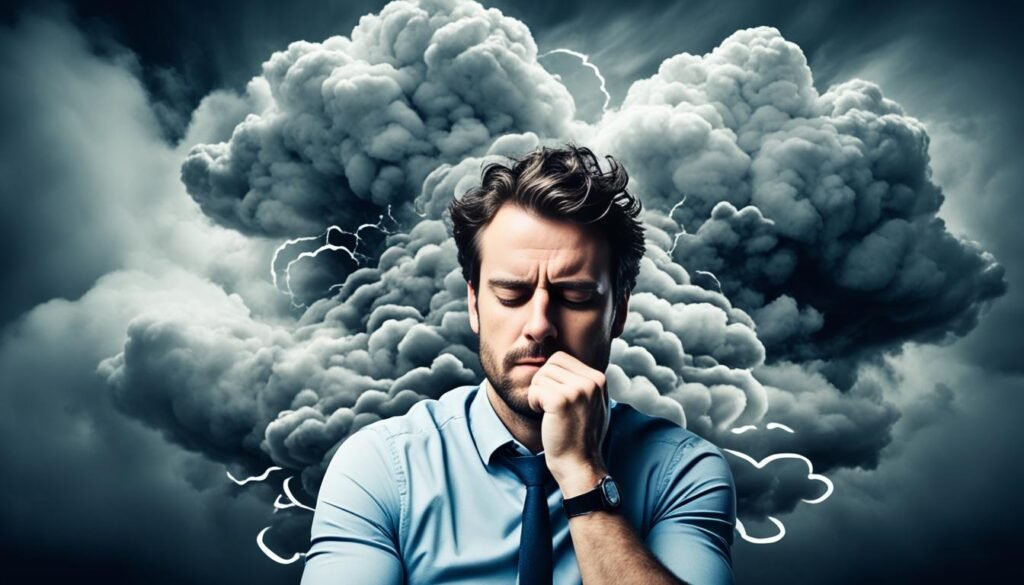 |
 |
This visual representation showcases the transformation from a cloud filled with worries to a cloud that is blown away by the wind, symbolizing the release of anxiety and the sense of freedom.
The Worry Cloud exercise can be a therapeutic way to let go of anxious thoughts and find solace in the act of creating art. Give it a try and experience the calming effects it can have on your mind and emotions.
Comfort Castle Exercise
Creating a personal castle of comfort can be a powerful art therapy exercise for reducing anxiety and promoting a sense of control. The comfort castle exercise involves envisioning and constructing a metaphorical castle that represents different coping strategies and comforts.
Imagine your comfort castle as a multi-level fortress where each level has its unique purpose in helping you manage anxiety. As you build your castle, think about the specific coping strategies or comforts that resonate with you.
Here's a step-by-step guide to creating your own comfort castle:
- Foundation level: This level represents the foundation of your comfort castle. What are the fundamental coping strategies and self-care practices that support your well-being? These could include activities like exercise, deep breathing, or connecting with nature.
- Security level: The security level is where you incorporate additional coping strategies that provide a sense of security and stability. This could involve setting healthy boundaries, seeking support from loved ones, or engaging in relaxation techniques like meditation or yoga.
- Creativity level: This level is dedicated to creative outlets that bring you joy and help you express your emotions. Consider incorporating activities like painting, writing, dancing, or playing an instrument into your comfort castle.
- Self-care level: The self-care level is all about activities that nourish your mind, body, and soul. Think about what brings you comfort and relaxation, such as taking bubble baths, practicing mindfulness, or indulging in your favorite hobbies.
- Inspiration level: The inspiration level is where you gather motivational quotes, affirmations, or images that inspire you during challenging times. These visual reminders can uplift your spirits and provide encouragement when anxiety arises.
Remember, your comfort castle is a personal sanctuary that reflects your unique needs and preferences. Feel free to customize it according to your specific anxieties and coping mechanisms.
Below is an example of how you can visually represent your comfort castle:
| Foundation level | Security level | Creativity level |
|---|---|---|
| Exercise | Setting boundaries | Painting |
| Deep breathing | Seeking support | Writing |
| Connecting with nature | Relaxation techniques | Dancing |

By visualizing your comfort castle and incorporating these coping strategies and comforts into your daily life, you can establish a sense of control over your anxiety and create a safe space for yourself.
Conclusion
Engaging in art therapy exercises can be a transformative journey towards reducing anxiety and finding inner peace. These exercises provide individuals with a creative outlet to express their emotions, promote relaxation, and enhance self-awareness. By incorporating art therapy techniques into their daily lives, individuals can effectively manage anxiety and improve their overall mental well-being.
Art therapy offers numerous benefits for individuals struggling with anxiety. It helps regulate the nervous system, reduces rumination, encourages focus and mindfulness, and increases self-esteem. These exercises also provide a distraction from external sources of stress and promote self-expression.
Whether it's through mind-body connection exercises, 1-minute brain dumps, mind maps, gratitude journaling, visual starters, worry clouds, or comfort castles, art therapy empowers individuals to explore their anxieties and develop effective coping strategies. By embracing their creative instincts, individuals can navigate their anxieties, reduce stress levels, and improve their overall quality of life.
FAQ
What is anxiety?
Anxiety is a common mental health issue characterized by excessive fear and worry. It can manifest as stress, nervousness, or restlessness. Anxiety can affect our daily lives and disrupt our ability to function normally.
What are the benefits of art therapy for anxiety?
Art therapy offers numerous benefits for individuals struggling with anxiety. It helps regulate the nervous system, reduces rumination, encourages focus and mindfulness, and increases self-esteem. Art therapy exercises also provide a distraction from external sources of stress and promote self-expression. By engaging in art therapy, individuals can experience a sense of calm, improved well-being, and enhanced problem-solving skills.
What is the mind-body connection exercise?
The mind-body connection exercise involves drawing the outline of a body while reflecting on physical sensations and tensions in the body. By incorporating these physical feelings into the drawing, individuals can become more aware of the mind-body connection and promote relaxation.
What is the 1 minute brain dump exercise?
The 1 minute brain dump exercise involves drawing a thought bubble and quickly writing or drawing all the anxious thoughts or worries in a minute. It serves as a quick release of anxious feelings and can help individuals let go of overwhelming thoughts.
What is the mind map anxiety exercise?
The mind map anxiety exercise involves creating a mind map focusing on a specific anxiety-inducing situation. The mind map includes different components such as triggers, emotional and physical feelings, negative thoughts, and calming techniques. This exercise helps individuals understand the different aspects of their anxiety and identify effective coping strategies.
What is the gratitude journaling exercise?
The gratitude journaling exercise involves using journaling to explore gratitude in different areas of life. It can be done generally or focused on specific situations that cause anxiety. By focusing on gratitude, individuals shift their perspective and find positive aspects in their lives, which can reduce anxiety and promote a sense of well-being.
What is the visual starter exercise?
The visual starter exercise involves using a provided visual stimulus to create an artwork. It is a helpful exercise for individuals who feel anxious about creating art as it provides a starting point and prompts for inspiration.
What is the worry cloud exercise?
The worry cloud exercise involves drawing a cloud and placing all worries inside it. Individuals then transform the drawing to show the worries being blown away by the wind. This exercise helps individuals externalize their worries and visualize letting go of anxious thoughts.
What is the comfort castle exercise?
The comfort castle exercise involves creating a personal castle of comfort, with each level representing different coping strategies and comforts. This exercise provides a tangible and visual representation of individuals' abilities to deal with anxious feelings and promotes a sense of control.
How can engaging in art therapy exercises help reduce anxiety?
Engaging in art therapy exercises can be a transformative journey towards reducing anxiety and finding inner peace. These exercises provide individuals with a creative outlet to express their emotions, promote relaxation, and enhance self-awareness. By incorporating art therapy techniques into their daily lives, individuals can effectively manage anxiety and improve their overall mental well-being.
